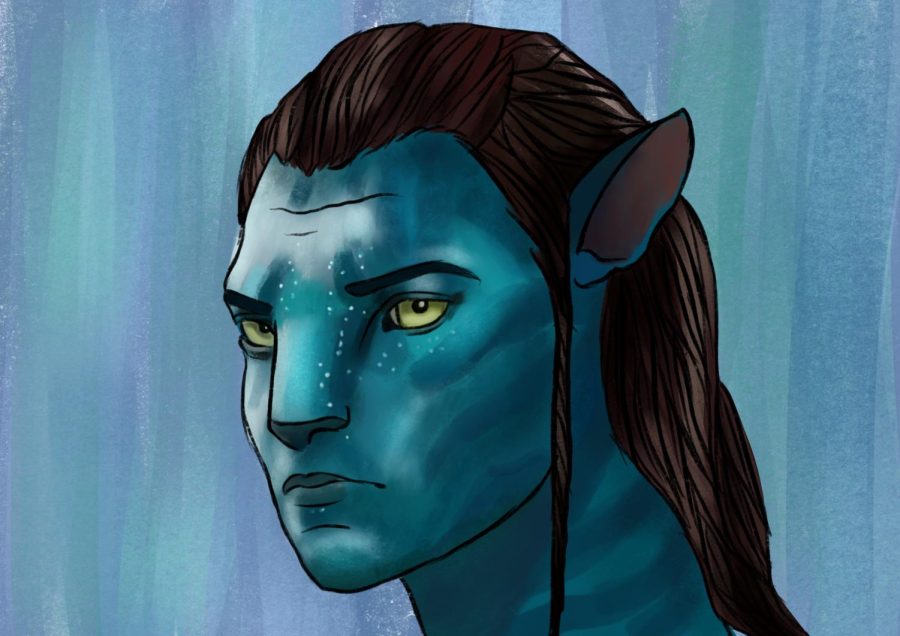‘Avatar: The Way Of Water’ looks great bro
Avatar is visually stunning, if not structurally simple.
January 13, 2023
Avatar: The Way Of Water does not have the cleanest plot or the smartest script, and from a film standpoint it is somewhat mediocre, yet it does not feel that way.
The first Avatar movie was groundbreaking back in 2009 in terms of visual effects and holds up very well 13 years later. Yet, a lot has changed in the film industry since then. As the high use of computer graphics in movies started becoming normal, studios like Marvel have been accused of overusing them, leading to degraded content. In the current state of visual effects, Avatar’s charm seemed like it would be less novel.
Yet, James Cameron’s ambition manifests in another monumental cinematic experience, despite retaining the faults of the first movie.
The visuals in The Way of Water are strong. There is thought and purpose behind every detail, because Cameron thought about the ecology and intent, rather than creating things because they look cool. The characters, music and the story depend on a consistent world. The visuals are not just pretty, they are powerful. But they kind of have to be, because the graphics in The Way of Water have a greater weight than in most movies.
Avatar as a franchise centers around the idea of escapism. Immersing viewers into this fictional world is crucial for Avatar so that the audience can connect on that spiritual level that blockbusters do not normally touch. So it makes sense that this is The Way of Water’s strongest attribution because it convinces the audience to suspend their disbelief the most, especially since the other parts of this movie do not offer anything new to the plot.
The film, much like its predecessor, follows a clear good versus evil conflict and falls to one dimensional characters and the white savior complex. The little nuance it tries to introduce with Quaritch and Spider serves the movie less than it teases future sequels. There are even high school drama tropes sprinkled throughout the film. The high attention to detail and level of effort that is present throughout the world and the lore is absent in the central plot and the script.
The alien teenagers in this movie love saying “bro” and “cuz”. They stick their tongues out to mock other characters. The script attempts to make the Na’vi more relatable, when they should feel more unique and foreign. In an early scene, Jake Sully claims that he had learned the Na’vi language so well that it sounds like English to him, which justifies why all the Na’vi speak English. Yet, certain lines still feel off-putting and out of place. With a lot of the human antagonists being one-dimensional bad guys that high-five while committing atrocities and the main characters making questionable moves, there is not a lot of complexity behind Cameron’s opus. So at its three-hour runtime, The Way of Water, with all its flaws, would have been a hard pill to swallow if the visuals were not so entrancing.
The attacks on nature, as obnoxious as they are, work because Pandora’s nature is so enthralling. The actors playing Na’vi characters do not look like Computer Graphics (CG) models. They look real because of how advanced the motion tracking technology is. Viewers get to see all the intricacies and imperfections in the actors’ performances. The slightest twitches in the lips or the precise movements of the eyes all allow the audience to connect with a CG character as if they were a real actor. There were some incredible performances from actors such as Zoe Saldaña and Britain Dalton, which is a strange feat for a movie with CG characters.
Avatar: The Way of Water brings wonder back to the big screen, and proves that 3D viewings, when done right, can greatly enhance the immersion instead of causing a headache. Yes, the plot is simple, and the themes are basic, but the film itself shines where it needs to shine the most. It delivers a raw spectacle that is more memorable than the antecedent. Let the heart lead, and The Way of Water will dazzle for a brief three hours.









